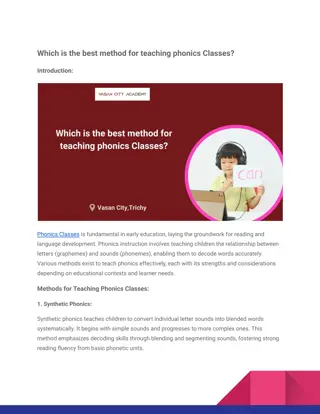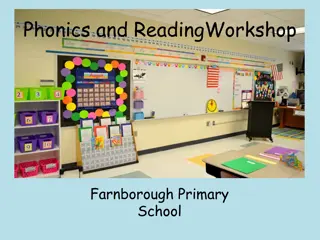
What are the best strategies for teaching phonics classes to students
The method for teaching phonics classes involves correlating sounds with symbols in an alphabetic writing system, a fundamental aspect of The education of learning.
Download Presentation

Please find below an Image/Link to download the presentation.
The content on the website is provided AS IS for your information and personal use only. It may not be sold, licensed, or shared on other websites without obtaining consent from the author. If you encounter any issues during the download, it is possible that the publisher has removed the file from their server.
You are allowed to download the files provided on this website for personal or commercial use, subject to the condition that they are used lawfully. All files are the property of their respective owners.
The content on the website is provided AS IS for your information and personal use only. It may not be sold, licensed, or shared on other websites without obtaining consent from the author.
E N D
Presentation Transcript
What are the best strategies for teaching phonics classes to students? Introduction: The method for teaching phonics classes involves correlating sounds with symbols in an alphabetic writing system, a fundamental aspect of The education of learning. Effective phonics instruction allows students to break down words, improve their reading speed, and enhance their understanding skills. Below are some of the most effective strategies for teaching phonics classes to students. These strategies are designed to be interesting, effective, and adaptable to different learning styles. Multisensory Learning: Multisensory learning involves using multiple senses at the same time to improve memory and knowledge of written language. This approach is especially effective in phonics instruction because it engages students through visual, auditory, kinesthetic, and tactile pathways. For example, students can use sand trays to form letters with their fingers while stating the sounds. Other activities such as skywriting, using magnetic letters, and including movement and songs can make learning phonics more dynamic and enjoyable. Systematic and Explicit Instruction: Phonics instruction needs to be systematic and explicit, which means it should follow a structured sequence and be clearly explained to students. Begin with simple letter-sound relationships and progress gradually to more complex patterns. Explicit instruction involves directly teaching students the relationship between letters and sounds, rather than expecting them to figure out these rules on their own. For instance, start with single consonant sounds and short vowels, then progress to blends, digraphs, and long vowel patterns. It is crucial to consistently review and reinforce previously learned concepts.
Phonemic Awareness Activities: Phonemic awareness involves recognizing, identifying, and manipulating individual sounds in spoken words. Before students can connect sounds to letters, they need to be able to recognize these sounds in isolation and within words. Activities such as rhyming games, segmenting and blending sounds, and sound substitution exercises help develop this important skill. For example, using picture cards, students can practice identifying the beginning, middle, and ending sounds of words. Decodable Texts: The use of decodable texts, which are books or passages made up of words that follow the phonics rules students have learned, helps reinforce their learning and build reading confidence. These texts allow students to use their phonics knowledge in context and support their ability to decode new words. Gradually increase the complexity of the texts as students' phonics skills improve, ensuring that they can practice new patterns while still reinforcing previously learned ones. Games and Interactive Activities: Incorporating games and interactive activities into phonics lessons makes learning enjoyable and engaging. Games such as phonics bingo, matching games, and word hunts can motivate students to practice their skills in a playful environment. Online phonics games and apps can also offer interactive and personalized practice opportunities. These activities can be adapted to focus on specific phonics skills and can be used for both individual and group work. Small Group Teaching: Teaching smaller groups allows for more personalized and varied phonics instruction. By grouping students according to their current skill levels, teachers can offer instruction tailored to their specific needs. This setting also provides more focused practice and immediate feedback. In small groups, teachers can use assessments to pinpoint areas where students require more support and provide specific interventions. Regular Practice and Review: Mastering phonics necessitates consistent practice and repetition. Integrate phonics practice into everyday activities such as morning messages, reading centers, and homework assignments. Regular review and cumulative practice help reinforce skills and ensure that students remember and can apply their phonics knowledge. Returning to previously covered concepts in different contexts also helps solidify learning.
Integration of Technology: Technology can be a valuable asset in phonics instruction. Interactive whiteboards, tablets, and educational software provide engaging methods for students to practice phonics skills. Apps that offer phonics games, interactive e-books, and digital flashcards can complement traditional teaching methods. Technology can also offer immediate feedback and personalized learning experiences, allowing students to progress at their own pace. Parental Participation: Encouraging parental involvement in phonics education can significantly enhance student learning. Provide parents with resources and strategies to support phonics practice at home, such as reading together, playing phonics games, and using flashcards. Regular communication with parents about their child s progress and ways they can help reinforce learning at home can create a supportive learning environment. Ongoing Educator Training: Continuous professional development for teachers is vital for effective phonics instruction. Staying updated on the latest research, instructional strategies, and resources can help teachers improve their practice and address the diverse needs of their students. Opportunities for professional development, such as workshops, webinars, and collaborative planning sessions, can offer valuable insights and support for phonics instruction. Conclusion: Teaching phonics classes is a crucial aspect of early literacy education. By using a range of strategies, including multisensory learning, systematic instruction, phonemic awareness activities, and technology integration, teachers can create engaging and effective phonics lessons. Small group teaching, consistent practice, and parental involvement further bolster students' phonics development. Continuous professional development ensures that teachers are equipped with the best practices to help all students succeed in reading. For more information: Address: Vasan City, Tiruchirappalli, Tamil Nadu, 620102 Call us: +91 7010975193 Map Location: https://maps.app.goo.gl/rvyh3WQDPJE6D95Q9






















